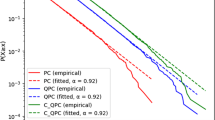Abstract
Technological resources are shown to be more concentrated to a few firms than economic wealth. To explain such concentrations, the self-multiplication process with cycle between the innovative and stagnant ages is modeled in terms of the stochastic process. This yields a family of new distributions which is named the ultra-Yule distribution. This new distribution which is quite skew is show to fit the real distributions of patents and of R & D expenditure in the Japanese industry better than the Yule distribution. The properties of this new distribution is discussed.
Similar content being viewed by others
References
J. AITCHISON, J. A. C. BROWN,The Lognormal Distribution, Cambridge University Press, Cambridge, 1957.
F. M. BASS, A New Product Growth Model for Consumer Durables,Management Science. 15 (1969) No. 5, 215–227.
H. ETO, K. MAKINO, Theoretical and Empirical Analysis of Differentiation Process in Technology Gap between Developed and Developing Nations, in:International and Regional Conflicts: Quantitative Approaches, W. ISARD et. al. Eds, Chap. 9, 149–159, Ballinger Pub. C., Cambridge, Mass., 1983.
W. FELLER,An Introduction to Probability Theory and Its Applications, I, John Wiley, New York, 1950.
Y. IJIRI, H. A. SIMONSkew Distributions and the Sizes of Business Firms, North-Holland, Amsterdam, 1977.
Japan Patent Information Center, JAPATIC Data Base for Top 2000 Firms. Tokyo, 1981.
G. L. LILIEN, The Implication of Diffusion Models for Accelerating the Diffusion of Innovation,Techonological Forecasting and Social Change, 17 (1980) 339–351.
V. MAHAJAN, R. A. PETERSON, Integrating Time and Space in Technological Substitution Models,Technological Forecasting and Social Change, 14 (1979) 231–241.
Nippon Keizai Shimbun (Nippon Economic Journal), Corporate Informations, 1980 Fall and 1981 Fall, Tokyo,
D. SAHAL, A Theory of Measurmeent of Technological Change, InternationalJ. Systems Science, 8 (1977) No. 6, 671–682.
Science and Technology Agency of Prime Ministers Office of Japan (Ed), Science and Technology Indicator, 1981, Tokyo.
A. L. YABLONSKY, On Fundamental Regularities of the Distribution of Scientific Productivity,Scientometrics 2 (1980) 3–34.
H. YODA,Introduction to Reliability Theory (in Japanese), Asakura Pub. C., Tokyo, 1972.
Author information
Authors and Affiliations
Rights and permissions
About this article
Cite this article
Eto, H., Makino, K. Stochastic model for innovation and resulting skew distribution for technological concentration with verification in Japanese industry. Scientometrics 5, 219–243 (1983). https://doi.org/10.1007/BF02019739
Received:
Issue Date:
DOI: https://doi.org/10.1007/BF02019739




